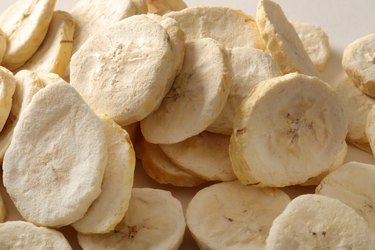
Does your family love bananas (Musaceae sapientum, USDA plant hardiness zones 7-11) but hate when they go bad? You're not alone, but did you know that you can freeze-dry bananas to preserve them for later use? Bananas that go bad become food waste, and no one wants to contribute to that issue. This problem is especially the case for bananas because they are the ultimate food for on-the-go people. They're portable and easy to eat, making them a great addition to any lunch.
You may be surprised to learn that bananas are botanically berries. The division a fruit falls under is ruled by the part of the plant that develops into the fruit. In this case, bananas fall under the berry category due to the several small seeds within the fruit. You may have never even noticed that bananas have seeds. Next time you're ready to freeze-dry bananas, look at their little seeds.
Video of the Day
Video of the Day
Freeze-Drying Bananas
Freeze-drying bananas is a great way to save this delicious snack. You can do it at home with a few simple steps or with the use of a specific machine. Many products on the market use various methods to freeze-dry fruit and other foods. To freeze-dry bananas, you'll need access to a freezer that can fit a cooling rack. You'll also need several bananas, preferably before they've turned entirely brown.
Start by peeling and slicing the bananas as thinly as possible and then lay these slices on the rack so they don't overlap. Make sure that the freezer is frost-free, as this will contribute to further browning. Keep them in the freezer for up to seven days to ensure complete freezing. After that time, take them out and allow them to thaw. The resulting slices will be perfect freeze-dried banana.
Types of Bananas
While you may think all bananas are the same (a long fruit with a yellow peel), there are actually plenty of different types of bananas and banana trees. The best type of banana tree for a home garden is a dwarf banana tree. These smaller trees are about 7 to 15 feet tall and can come in several varieties. Some of these include the Dwarf Brazilian (Musa acuminata 'Dwarf Brazilian,' zones 9-11), which grows to 8 feet tall, the Dwarf Cavendish (Musa acuminata Cavendish, zones 4-11), which only grows to about 5 feet, and the ice cream tree (Musa acuminata × balbisiana 'Blue Java,' zones 4-11), which has sweet fruit that tastes like vanilla custard.
Plantains are also a type of banana. These starchier fruits are often larger and can appear more green than yellow. Plantains have an incredibly high starch content that makes them better for cooking, and they are often used in savory dishes since they contain less sugar than the traditional banana. Plantains were initially from southeast Asia but are now grown all over the world.
Health Benefits of Bananas
Beyond simply being one of the most popular snacks, bananas are also one of the most nutritious. They're rich in fiber and several antioxidants. A regular-size banana weighs 126 grams and has nearly 12 percent of the daily value of vitamin C, which aids in boosting immunity. Additionally, that banana will also have 3 grams of fiber and 11 percent of the daily value of copper. These benefits make bananas a powerful punch of nutrients.
In addition, bananas are an excellent source of potassium. This mineral is vital for heart health and blood pressure management. High blood pressure can lead to increased risk of heart disease. The average person between 19 and 50 years of age should be getting 2,600 to 3,400 milligrams of potassium per day. A single banana provides 10 percent of the daily recommended value of potassium.
- Britannica: Musaceae
- This Old House: A Guide to Dwarf Cavendish Banana Trees
- Bananas.org: Musa Dwarf Brazilian
- FastGrowingTrees: Ice Cream Banana Tree
- Healthline: Is a Banana a Berry or Fruit? The Surprising Truth
- Southern Living: Banana
- Healthline: 11 Evidence-Based Health Benefits of Bananas
- National Institutes of Health: Potassium